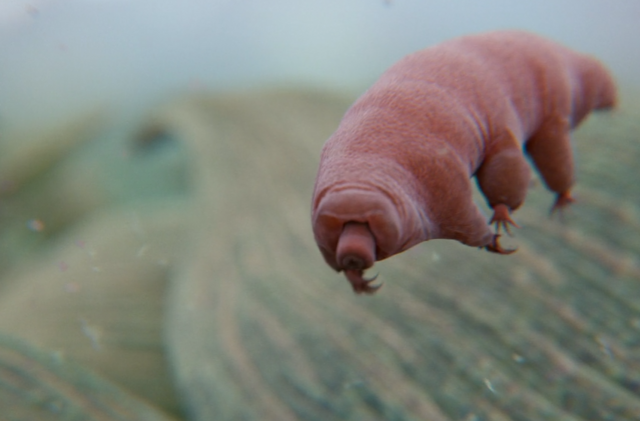Tardigrades are extraordinary 8-legged survivors. These tiny aquatic invertebrates, also known as water bears, can withstand UV radiation, the vacuum of space, and even being shot out of a gun! Scientists have described more than 1,400 tardigrade species from freshwater and marine habitats worldwide. The seemingly indestructible creatures have earned the title of “toughest animals on Earth,” but are they tough enough to survive on Mars?
Space agencies across the globe are currently laying the groundwork to send humans to Mars, but living on Mars would come with unique environmental challenges. Researchers have shown tardigrades can survive the radiation, extreme temperatures, dehydration, and lack of oxygen that characterize the red planet. But scientists studying Martian soil realized it contains toxic salts called perchlorates. Perchlorates rapidly dissolve in solution, forming salty solutions, or brines, that hinder a cell’s ability to retain water. They also produce reactive chemicals like hydrogen peroxide that damage cells in a process called oxidative stress. Scientists found perchlorate levels in Martian soils as high as 0.6%, about 1,000 times more concentrated than the highest levels found in desert soils on Earth.
Scientists in the past found that some soil bacteria can withstand perchlorates using specialized enzymes that counteract these salts or protect their cells from oxidative stress. Unfortunately, animals don’t have these enzymes. Other researchers showed the tardigrade Paramacrobiotus experimentalis can survive short-term exposure to perchlorates for up to 24 hours. But animals living on the Martian surface would have to permanently contend with these toxins.
A team of researchers from Poland recently tested whether tardigrades were up to the task. They placed Pam. experimentalis in high perchlorate levels nearing those of Martian soils for 8 weeks to see how long they survived. They reasoned that since this particular tardigrade species could withstand short-term exposure to perchlorates, it might also survive longer times.
The researchers collected specimens of Pam. experimentalis from mosses in Madagascar and fed them a diet of worms and plankton. For each experiment, they transferred 24 newly hatched juveniles into solutions with 0.10%, 0.15%, 0.20%, or 0.25% magnesium perchlorate. They transferred another 24 into a solution without perchlorates as a control. They kept the tardigrades in these solutions for 56 days, in the dark, at 18°C (about 64°F), and 40% relative humidity. They refreshed their solutions every 7 days and removed any that died.
At the end of the experiments, the researchers examined the tardigrades using a phase-contrast microscope. This type of microscope exploits the fact that when light waves interact with an object, they change in both height, or amplitude, and position, or phase. The human eye can see amplitude changes through brightness or color intensity but can’t see phase changes. The phase-contrast microscope converts invisible phase changes into visible brightness changes so scientists can see fine details in transparent specimens, like tardigrades.
The team counted live versus dead tardigrades under the phase-contrast microscope and found that 83% survived in 0.10% magnesium perchlorate, similar to the 87% in the control group. They also found that about 58% of the tardigrades survived in 0.15% perchlorate, 29% in 0.20% perchlorate, and 20% in 0.25% perchlorate. They interpreted this trend to mean that perchlorates above 0.10% were toxic to most tardigrades, but some individuals could survive perchlorate levels about half of those found on Mars.
The researchers also measured the body lengths of the surviving tardigrades. They found tardigrades grown with perchlorates were about 2/3 as long as those grown without. They suggested the tardigrades grew slower in the presence of perchlorates because the salt either directly inhibited their growth or stopped them from eating.
These scientists demonstrated that tardigrades could survive for 8 weeks in near-Martian perchlorate levels, but not how they did it. They speculated that tardigrades withstood toxic perchlorates by entering a desiccated hibernation state like when they face high concentrations of common salts or other extreme conditions. Alternatively, they could have used protective molecules like the damage suppressor protein that protects them from radiation to help them survive.
The team recommended future researchers investigate whether tardigrades can live and reproduce when simultaneously exposed to perchlorates and other harsh conditions present on Mars. They also suggested scientists study the biochemical pathways involved in tardigrades’ perchlorate tolerance to determine whether these pathways could be genetically engineered to bestow perchlorate resistance on other animals destined for Mars. Someday, future humans might be sporting tardigrade-enhanced skin for a stroll under the Martian sky!


